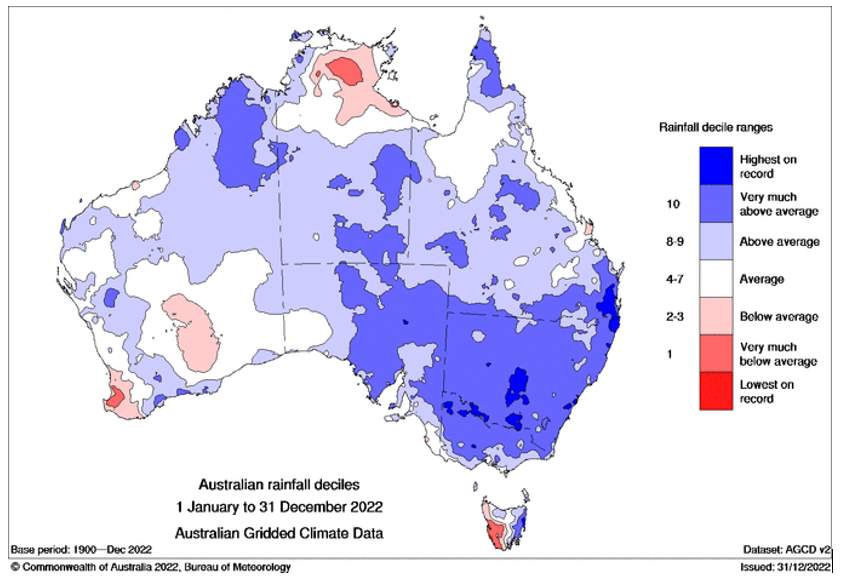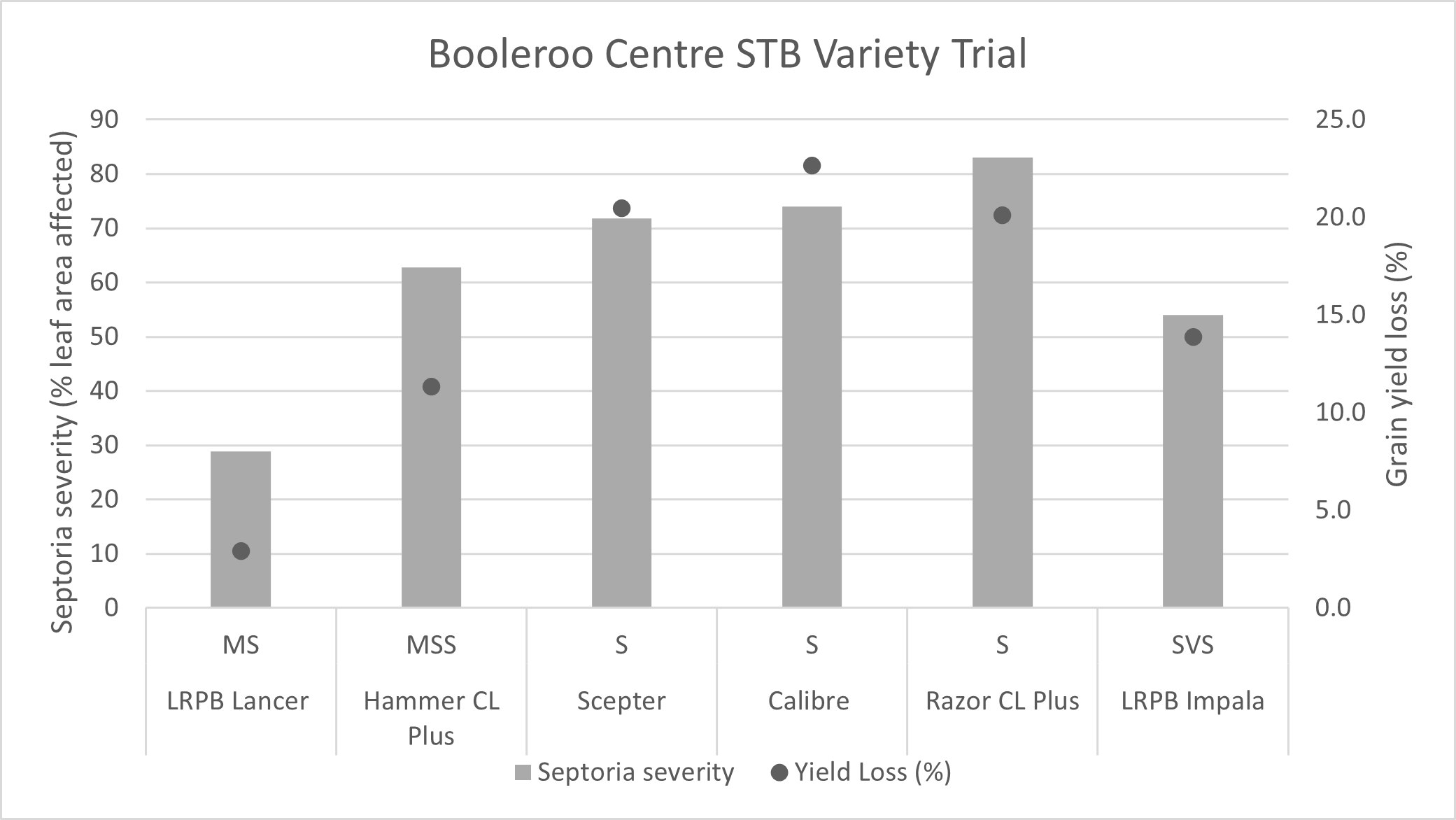Wheat disease update – septoria tritici blotch and stripe rust
Author: Tara Garrard (South Australian Research and Development Institute, The University of Adelaide) | Date: 07 Feb 2023
Take home messages
- Above average rainfall in 2022 favoured disease development.
- 2022 season resulted in high stripe rust disease.
- Septoria tritici blotch, usually damaging in the HRZ, caused yield losses of 20% in the LRZ.
- Inoculum levels will be high going into 2023: green bridge control, variety selection and fungicide strategies should be prioritised.
Background
The 2022 growing season in South Australia received above average rainfall in most areas of the state (Figure 1). Wet conditions continued late into spring and early summer affecting conditions during grain fill and harvest. These conditions were very conducive for foliar disease development and wheat crops particularly suffered from powdery mildew, stripe rust and septoria tritici blotch. Many paddocks experienced yield losses, reduction in grain quality and/or grain defects from disease pressure. Integrated disease management strategies were particularly important in this season with variety selection, proactive fungicide management and non-chemical farm management (for example, green bridge control, crop rotation and stubble management) providing the best opportunity for effective disease control.

Wheat stripe rust
Stripe rust caused substantial damage and yield loss to wheat crops in the eastern states in 2022. Summer rainfall through 2021 and 2022 caused flooding in QLD and NSW, driving a green bridge between the growing seasons and allowing stripe rust inoculum to proliferate. Stripe rust epidemics began early in these growing regions in 2022 and South Australia followed suit with the first stripe rust report in late July. Wet cool conditions for the remainder of the season maintained a high level of disease pressure from stripe rust in susceptible varieties. Paddocks that avoided susceptible varieties, had fungicides applied at seeding, and had timely foliar fungicide applications achieved the greatest stripe rust control.
The stripe rust disease risk is expected to be high in 2023 with high inoculum loads across the state from the 2022 season. Green bridge control will be essential in the lead up to sowing, as volunteers host the rust inoculum. Growers should be prepared for the rust epidemic to begin early in the season and have an integrated disease management plan ready to implement. A successful stripe rust integrated disease management plan will include:
- green bridge control
- variety selection – avoid susceptible varieties
- up front fungicide applications – in furrow, seed dressings, coated fertiliser
- proactive foliar fungicide applications
- use of support tools such as the StripeRustWM App.
Septoria tritici blotch
Septoria tritici blotch (STB) was prevalent across the state in 2022, with higher-than-average spring rainfall causing substantial disease development in some areas. The disease is spread via rain splash and infection on the top three leaves is a driving factor for yield loss. Typically, yield losses are observed in the high rainfall zones (HRZ) of the state, but seasons such as 2022 were conducive to yield losses in low and medium rainfall zones (LRZ, MRZ respectively).
In 2021 and 2022, SARDI in conjunction with Agriculture Victoria and the GRDC have conducted field trials in low and medium rainfall zones to quantify yield losses in wheat varieties. Six varieties were selected based on their disease resistance ratings to STB. Ratings for stripe rust and powdery mildew were taken into consideration as well. Varieties and STB resistance ratings were as follows: LRPB Impala SVS, Calibre S, Scepter S, Razor CL Plus S, Hammer CL Plus MSS and LRPB Lancer MS.
Trials were a split-plot design with disease-inoculated plots (‘plus-disease’) and disease-controlled plots (‘minus-disease’) for each variety. Treatments were replicated six times and were blocked by disease treatment, with plot size of 10m x 1.5m. In South Australia, trials were located at Hart Field Site and Booleroo Centre.
Plus-disease plots were inoculated at seedling and mid-tillering stages using a conidial suspension in water applied as a spray. Fungicides were applied to minus-disease plots at GS 31 and GS 39. The GS 31 spray consisted of Elatus® Ace (250g ai/L propiconazole + 40g ai/L benzovindiflupyr) at 500mL/ha and the GS 39 spray was epoxiconazole (500g ai/L) at 125mL/ha. Disease assessments were conducted at flowering by assessing percentage of leaf area infected on each leaf of 10 plants/plot. Single site statistical analysis was conducted with Genstat 20th Edition.

Figure 2. Grain yield losses and STB disease severity at Booleroo Centre STB variety trial in 2022. Yield losses were significant in Hammer CL Plus, Scepter, Calibre, Razor CL Plus and LRPB Impala.

Figure 3. Grain yields and STB disease severity at Hart Field Site STB variety trial in 2022. No significant yield losses were recorded.
The Booleroo Centre site received higher than average rainfall in 2022 with 330mm of growing season rainfall (April–November) compared to the 305mm average. The late winter and spring months were the major contributors to this rainfall total. Resultingly, both yields and Septoria disease severity were high at the site and yield losses from STB were recorded in all varieties except in the moderately susceptible (MS) variety LRPB Lancer. The yield average at the site was 5.7t/ha and yield losses were highest in susceptible (S) varieties Calibre, Scepter and Razor CL Plus with corresponding disease severities of 74%, 72% and 83% at early milk development, respectively.
The Hart field site had above average growing season rainfall with 417mm (April–November) and a yield average of 3.5t/ha. The disease severity at the site was lower than at the Booleroo Centre site with the highest level in Scepter at 30% at the end of flowering.
The 2021 growing season was not as conducive for STB disease development with the highest levels at the Hart field trial in SVS variety Impala at 11 % at flowering time. Disease levels at the Booleroo Centre field trial were very low and neither site recorded yield losses associated with the disease. The takeaway message from the past two years of trials was that in 2021 it was not economical in the LRZ and MRZ to control STB, but in 2022, STB control increased yield by 22% in susceptible varieties at the Booleroo Centre LRZ site.
Inoculum levels from the 2022 season will be high and growers should be aware of the disease risk going into 2023. STB inoculum carries over on stubble and spores can be spread long range early in the growing season. Therefore, to reduce disease risk in 2023, it is important to implement crop rotation and avoid growing wheat on wheat stubble, as well as selecting a variety with some level of STB disease resistance.
Powdery mildew
SARDI Cereal Pathology received a large number of powdery mildew disease reports throughout the 2022 growing season. Areas of the state most affected were the Lower Eyre Peninsula, Yorke Peninsula, South East and the Mallee. Development of the disease in the Mallee region is an uncommon occurrence and was likely due to regular but low volume rainfalls during late winter and early spring. Many reports from across the state highlighted the difficulty in controlling the disease and the current prevalence of wheat powdery mildew strobilurin fungicide resistance and DMI reduced fungicide sensitivity were questioned. Current commonly sown varieties in South Australia have very poor genetic resistance to the disease and varieties rated very susceptible to susceptible (VS–S) dominate much of the cropping area. These factors, combined with a conducive growing season, produce a system in which substantial disease levels, yield loss and reduced grain quality are likely.
More detailed information on powdery mildew fungicide management strategies can be found in a separate GRDC update paper from Sam Trengove and respective authors at Trengove Consulting.
Wheat head diseases
Moist conditions continued throughout grain fill in the eastern parts of the state, causing impacts on grain quality. SARDI Cereal Pathology have been investigating the causes of quality reduction and grain damage and have received samples from all growing regions of the state. Grain samples have predominantly shown symptoms of severe grain shrivelling, fungal staining, black point as well as white and pink grains. A multitude of factors as well as fungal pathogens are likely to have contributed to these symptoms, with many samples displaying more than one impaired trait.
Causes of defected grain detected in SA in 2022:
- white grain disorder
- Fusarium head blight (Fusarium pseudograminearum – spread from crown rot infection)
- field moulds (Alternaria spp., Eppicoccum spp., Cladosporium spp.)
- foliar pathogens – loss of leaf area limiting yield, infected glumes, infection at flowering (stripe rust and septoria tritici blotch)
- black point (physiological – but there is varietal variation)
- frost
- Septoria nodorum blotch.
Growers are advised to assess their seed quality going into the 2023 growing season and select a cleaner seed source if necessary.
Conclusion
The 2022 growing season had exceptional rainfall conditions in late winter and spring resulting in high wheat foliar disease pressure. Yield losses and reduced grain quality were common across the state and, in some areas, difficult to avoid without dedicated integrated disease management. Stripe rust, Septoria tritici blotch and powdery mildew were the most damaging diseases and inoculum levels of these diseases will be high going into 2023. Growers should plan integrated disease management for 2023, with a focus on variety selection, green bridge control, crop rotation and proactive fungicide plans.
Acknowledgements
The research undertaken as part of this project is made possible by the significant contributions of growers through both trial cooperation and the support of the GRDC, the authors would like to thank them for their continued support. Funding for this work was provided by the South Australian Government and the GRDC through the GRDC projects: DJP2104-004TRX, DAS1905-013SAX, UOA2104-012RTX. The authors would also like to acknowledge the SARDI Cereal Pathology team, as well as collaborators on the STB project including Agriculture Victoria, Hart Field Site Group, Upper North Farming Systems, Birchip Cropping Group, AgXtra and the growers hosting sites, and the University of Sydney Cereal Rust Program.
Useful resources
Proactive fungicide management maintains disease-free crops
Recent and historical rainfall maps
Contact details
Tara Garrard
SARDI Cereal Pathology
Gate 2A Hartley Grove, Urrbrae SA 5064
0459 899 321
Tara.garrard@sa.gov.au
@TaraGarrard
GRDC Project Code: DJP2104-004RTX, DAS1905-013SAX, UOA2104-012RTX,
Was this page helpful?
YOUR FEEDBACK
